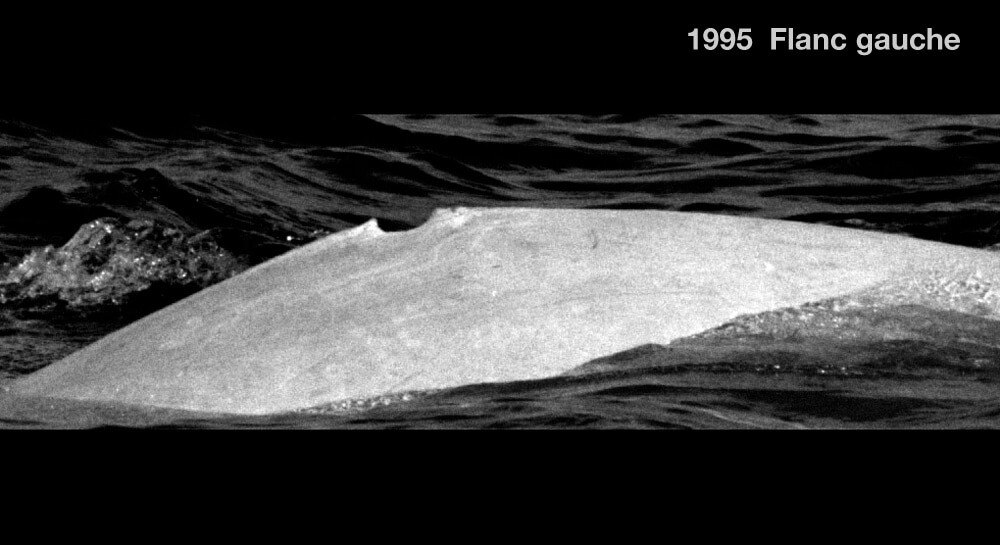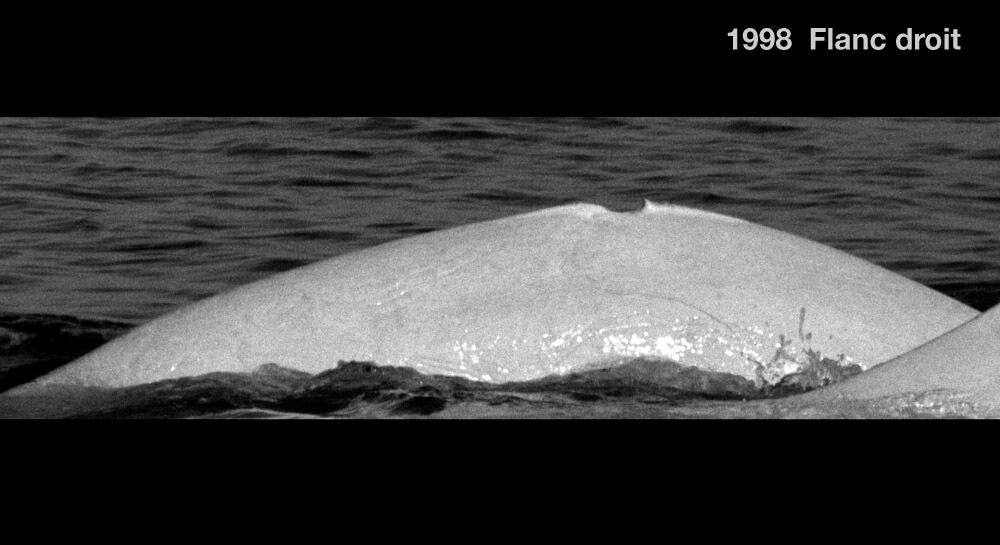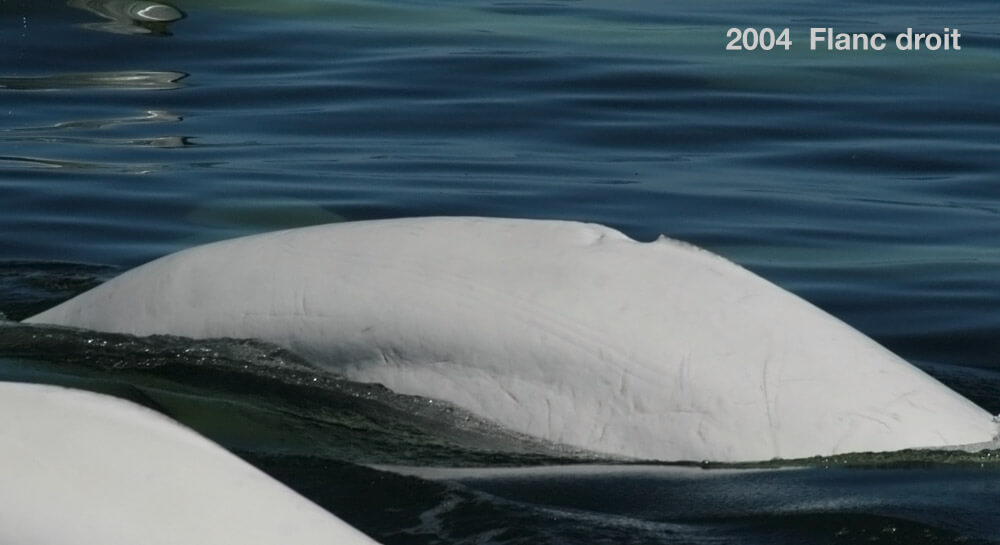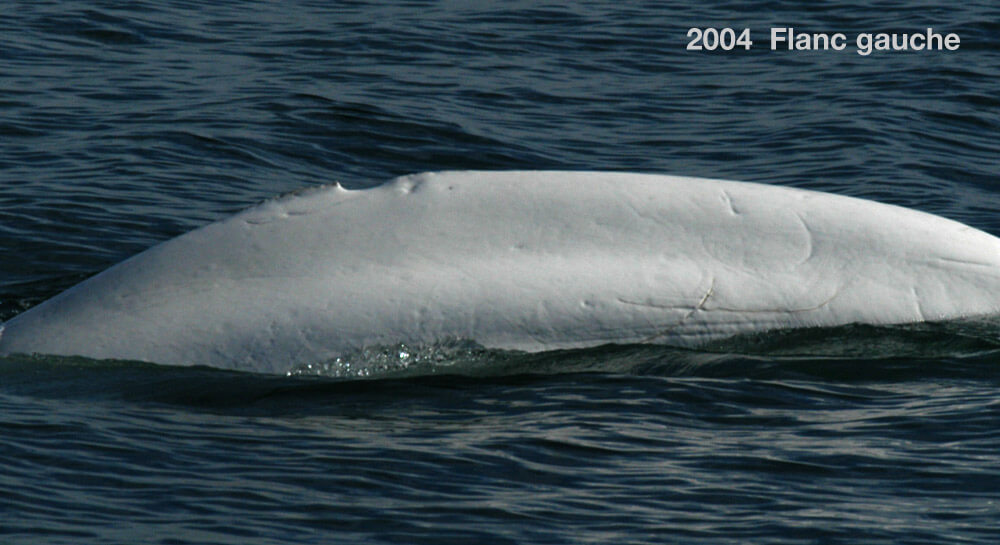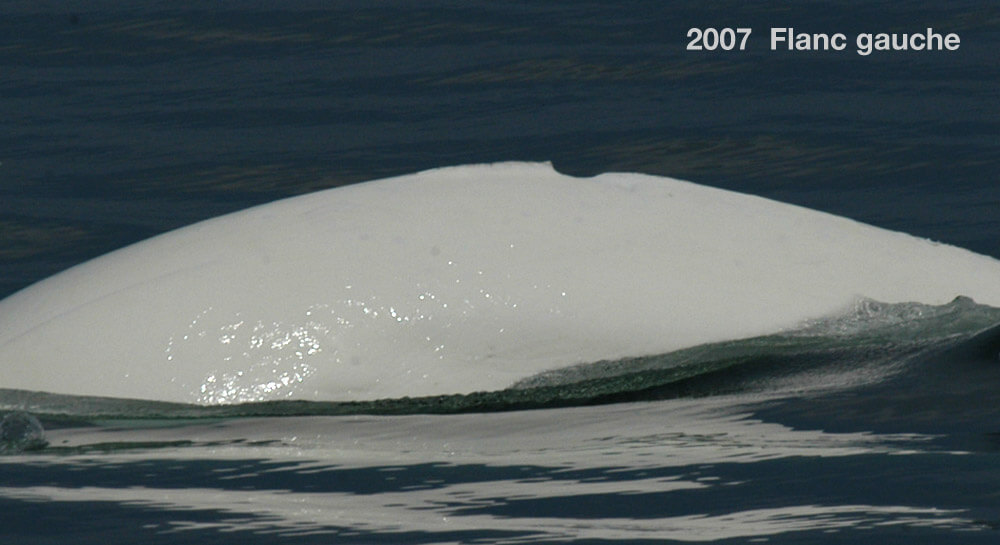Solidaire
Beluga


Adopted by the riverside municipalities of the St. Lawrence Solidary
-
ID number
DL0486
-
Sex
Male
-
Year of birth
Circa 1985
-
Known Since
1993
Distinctive traits
Solidaire can be easily recognized thanks to the long, deep scar at the end of his dorsal crest. Just below this scar, on each flank, a small dot can also be discerned, both of which have remained visible all these years.
His story
Our first encounter with Solidaire goes back to 1993. At the time, he was still gray. He faded little by little until he turned white in the early 2000s. Belugas fade from gray to white in colour between the ages of 12 and 16. Solidaire would therefore have been born in the mid-1980s.
Solidaire’s habits and associations suggest that he is a male. His sex was confirmed by biopsy in 2010 : he is male. When they reach adulthood, male belugas gradually form stable groups of companions. Three networks of males are known: two of these navigate the Saguenay Fjord and the head of the Laurentian Channel, while the third one, the “Downstream Boys”, also uses the head of the Channel as well as the downriver portion of the Estuary. These associations may play a role in belugas’ reproductive lives. Solidaire has no known faithful companion. He is regularly seen however with Lugi, Chérubin and DL1214, all males who, like Solidaire, have never been observed in the Saguenay River. This leads us to believe that they may be members of the “Downstream Boys”.
How Solidaire’s story unfolds will teach us volumes on the evolution of belugas’ social lives. For example, which sector will he favour as he grows older? Who will his lifelong companions be? By better understanding how belugas live, we will better be able to protect them.
Observations history in the Estuary
Years in which the animal was not observed Years in which the animal was observed
Latest news
Last winter, our research assistants undertook the meticulous analysis of some 13,000 photos collected throughout the summer of 2018.Thanks to this exercise, we were able to conclude that we spotted Solidaire at least once. Here is a description of this encounter.
We’re off the coast of Les Escoumins on board the BpJAM, our inflatable research boat. The sun glare on the water prevents us from obtaining an accurate count, but we have at least 70 belugas in front of us. We approach a cluster of 5 individuals to photo-identify them. All of a sudden, we start seeing pectoral fins poking above the surface and tails being lifted out of the water. We slip on our hockey helmet and leather gloves as we gear up to launch the drone. We also drop a hydrophone into the water to record the beluga’s vocalizations.
Once the drone has achieved lift-off, we observe the whales’ behaviours. The animals’ broad shoulders indicate that we are dealing with a group of bulls. They are strongly interacting, grazing and jostling one another. Within the group, we recognize Écho, Gaston, Solidaire, Lugi, DL2023 and DL0058. The herd splits into smaller groups of ten or so individuals, while a few of the animals are swimming alone. Two young grey belugas and one that is almost white – what we would call dirty white – approach the boat and and begin to nibble on our hydrophone. The animals pick up their pace and we film for the twenty minutes of battery life we have left before departing to search for another group.
Summer 2016, our 32nd season at sea with the belugas, was once again rich in encounters and surprises. Good news: after a notable three-year absence, we saw Solidaire again this summer. Since our first meeting in 1994, he has regularly been “missing in action”. We’re still trying to better understand these brief absences: do they reflect his travels or the vagaries of our sampling? [In hindsight, we discovered that Solidaire had been seen in 2015 and 2013, but that his identification had eluded us at first glance].
On July 29, 2016, we crossed paths with Solidaire near Ile aux Pommes off Trois-Pistoles. He swims among a herd of males, white adults and gray juveniles, including around 150 individuals. The herd is divided into about twenty groups.
The animals are very active: some belugas “porpoise”, i.e. they swim with their bodies out of the water, while others stick out their tails. We hear all kinds of vocalizations. Before taking photos, we have to spot the markings on the animals’ flanks. Despite the size of the herd, we manage to do the rounds, and several individuals show easily identifiable markings. Further analysis of the data will tell us who Solidaire’s comrades were that day.
As we start our day, we come across a lone beluga. We decided to continue towards Rimouski, in search of more belugas. As luck would have it, we came across a huge herd of around 200 belugas! The herd spreads out over a good distance and is divided into six groups. The size of the individuals tells us that they are mostly males, adults and juveniles. Among this mass of white backs, we recognize Solidaire, swimming in the company of two other well-known males, Jetstream and Trèfle.
We’re off Ile aux Basques, filming underwater images of beluga whales. Solidaire is immortalized on film with other white adults and grey juveniles that pass and repass under our boat. Belugas are gregarious and curious animals, and they sometimes examine boats. This investigative behavior exposes them to the risk of collision. That’s why St. Lawrence boaters are urged to exercise extreme caution in the presence of belugas, and if possible, to keep their distance.
Sponsors
The riverside municipalities of the St. Lawrence Solidary adopted Neige, Nics, Bilou, Cica and Solidaire (2014).
Beauharnois; Bécancour; Candiac; Carleton-sur-Mer; Charlemagne; Chute‐aux‐Outardes; Châteauguay; Contrecoeur; Grande Rivière; La Pocatière; Lanoraie; Les Bergeronnes; Louiseville; Lévis; Matane; Montmagny; Montréal; New-Richmond; Notre-Dame-des-Sept-Douleurs; Percé; Pincourt; Port-Cartier; Québec; Repentigny; Rimouski; Saint-André; Saint-Zotique; Sainte-Anne-de-Sorel; Sainte-Anne-des-Monts; Saint‐Ignace‐de‐Loyola; Saint‐Siméon; Salaberry-de‐Valleyfield; Sept-Iles; Sorel-Tracy; Tadoussac; Varennes
Click on the names below to discover texts, drawings and videos composed by children of participating schools on Facebook as part of the Our Beluga’s Name is… contest.
Neige was named by the special education class of the École Saint-Alexandre in Port-Cartier.
Nics was named by the 5th and 6th grade class of the École Élisabeth Turgeon in Rimouski.
Bilou was named by the 3th grade class of the École de Ste-Thérèse-De-L’Enfant-Jésus in Saint-Jérôme.
Cica was named by the 2th grade class of the École de la Ruche in Lévis.
Solidaire was named by the 5th grade of the École Our Lady of Pompei in Montreal.

